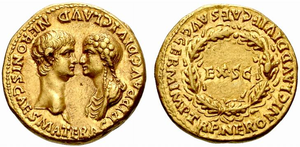AD 59
Appearance
This article needs additional citations for verification. (February 2016) |
| Millennium: | 1st millennium |
|---|---|
| Centuries: | |
| Decades: | |
| Years: |
| AD 59 by topic |
|---|
| Leaders |
| Categories |
| Gregorian calendar | AD 59 LIX |
| Ab urbe condita | 812 |
| Assyrian calendar | 4809 |
| Balinese saka calendar | N/A |
| Bengali calendar | −534 |
| Berber calendar | 1009 |
| Buddhist calendar | 603 |
| Burmese calendar | −579 |
| Byzantine calendar | 5567–5568 |
| Chinese calendar | 戊午年 (Earth Horse) 2756 or 2549 — to — 己未年 (Earth Goat) 2757 or 2550 |
| Coptic calendar | −225 – −224 |
| Discordian calendar | 1225 |
| Ethiopian calendar | 51–52 |
| Hebrew calendar | 3819–3820 |
| Hindu calendars | |
| - Vikram Samvat | 115–116 |
| - Shaka Samvat | N/A |
| - Kali Yuga | 3159–3160 |
| Holocene calendar | 10059 |
| Iranian calendar | 563 BP – 562 BP |
| Islamic calendar | 580 BH – 579 BH |
| Javanese calendar | N/A |
| Julian calendar | AD 59 LIX |
| Korean calendar | 2392 |
| Minguo calendar | 1853 before ROC 民前1853年 |
| Nanakshahi calendar | −1409 |
| Seleucid era | 370/371 AG |
| Thai solar calendar | 601–602 |
| Tibetan calendar | 阳土马年 (male Earth-Horse) 185 or −196 or −968 — to — 阴土羊年 (female Earth-Goat) 186 or −195 or −967 |

AD 59 (LIX) was a common year starting on Monday of the Julian calendar. At the time, it was known as the Year of the Consulship of Apronianus and Capito (or, less frequently, year 812 Ab urbe condita). The denomination AD 59 for this year has been used since the early medieval period, when the Anno Domini calendar era became the prevalent method in Europe for naming years.
Events
[edit]By place
[edit]Roman Empire
[edit]- March 23 – Emperor Nero orders the murder of his mother Agrippina the Younger. He tries to kill her through a planned shipwreck, but when she survives, he has her executed and frames it as a suicide.
- Gnaeus Domitius Corbulo, Roman commander in the east, captures Tigranocerta in Mesopotamia. He installs Tigranes VI, a Cappadocian prince, as ruler of Armenia. For the next four years, a cohort from Legio VI Ferrata and Legio X Fretensis is stationed in the capital as bodyguard to the king, supported by fifteen hundred auxiliaries.
- Publius Clodius Thrasea Paetus retires from the Roman Senate. He openly shows his disgust at the behaviour of Nero regarding the murder of Agrippina.
- Rioting breaks out between the people of Pompeii and the people of Nuceria during a gladiator fight in Pompeii. Thousands are killed.
By topic
[edit]Arts and sciences
[edit]- In the Satyricon, Petronius pokes fun at Roman immorality.
- An eclipse on 30 April over North Africa is recorded by Pliny the Elder in his Natural History.
Religion
[edit]- Paul the Apostle pleads his case and testifies to his Christianity before King Agrippa II of the Herodians, who responds "You almost persuade me to be a Christian."[1]
Deaths
[edit]- March 23 – Agrippina the Younger, mother of Nero (b. AD 15)
- Domitia Lepida the Elder, granddaughter of Mark Antony
- Gnaeus Domitius Afer, Roman politician and orator
- Servilius Nonianus, Roman consul and historian
References
[edit]- ^ New Testament, Acts 26.
